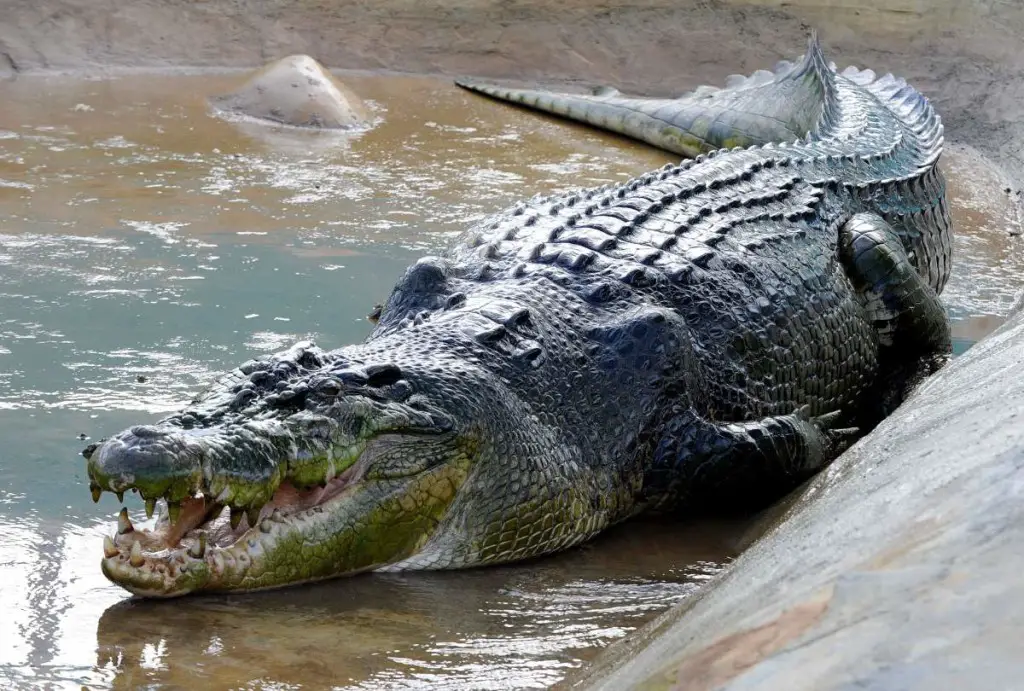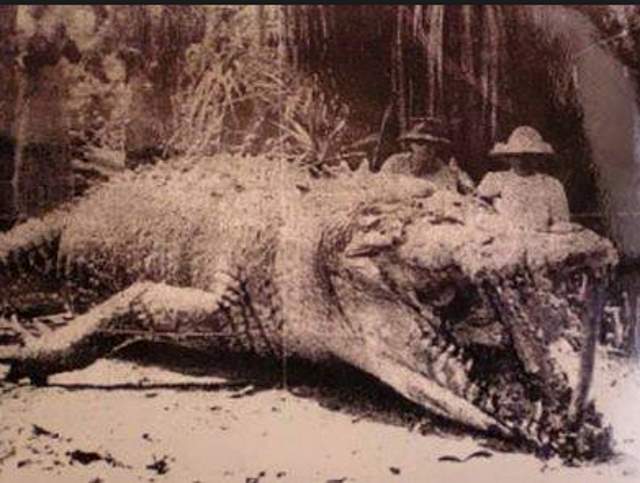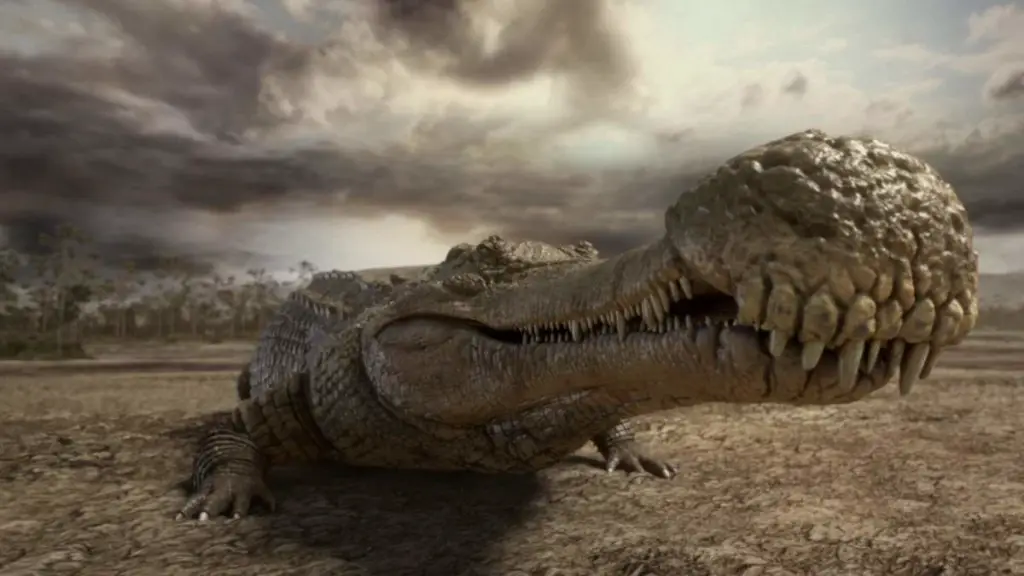World’s Top 9 Largest Crocodiles Ever Recorded
Crocodiles are large aquatic reptiles that live throughout the tropics in Africa, Asia, the Americas and Australia. Although they are big, they suffer from a prevalence of “big fish” stories and over-exaggeration. In the Internet age, photographs of crocodiles manipulated digitally to make the animal look much larger than it is. But how big are they actually? Here are the top nine largest crocodiles ever recorded (when I wrote the post, I didn’t know about Gomek; and after I published it, the Guinness World Record book has accepted a claim that a 23 ft/7.01 meters male saltwater crocodile weighing 2,000 kg lives within Bhitarkanika Park in the state of Orissa, India).
9. Puento Noire Crocodile
(5.40 meters/17.71 feet)

This unnamed monster crocodile has been at the center of a number of hoaxes. The fact is, this aggressive Nile specimen was killed in a safety operation near Puento Noire, Republic of Congo. Estimated size: 5.4 meters – 17 feet 8 in.
Current status: dead
Current status: dead
8. Gomek
(5.42 meters/17.8 feet)

Gomek was a large saltwater crocodile captured by George Craig in Papua New Guinea. He was purchased by Terri and Arthur Jones in 1985 and was kept in Ocala, Florida for five years before being sold to the St. Augustine Alligator Farm Zoological Park in Florida. For 8 years he wowed spectators with both his amazing nutria-tossing abilities and his even more amazing tolerance of people. Feeders of the large croc were allowed to go into the enclosure and get as close as 1 meter from the large animal (a normally suicidal proximity) without any fear of attack. While feeders still used long tongs to feed Gomek, he was generally considered to be a “tame” crocodile and was the favorite of the Alligator farm and people around the nation.After many years, Gomek died of heart disease on March 6, 1997. By then, he was a very old crocodile, and one of the largest and tamest captive crocodile in existence. When he died, he was 5.42 metres (17.8 ft) long, and weighed 860 kg (1896 pounds) – as confirmed by St. Augustine Alligator Farm – and probably between 60 and 80 years old. There is a tribute to Gomek near his enclosure, which now houses his successor Maximo and his mate Sydney.
Current status: dead
7. Cassius
(5.48 meters/17 feet 11 in)

This Australian saltwater giant has been claimed as the largest crocodile held in captivity, but in fact Yai is probably bigger. He lives in Marineland Melanesia on Green Island in Australia. He was captured in the Finis River in the Northern Territory after attacking boats and causing a nuisance.
Cassius is 5.48 meters (17 feet 11 in) long, and is believed to be around 110 year old.
Current status: alive
6. Yai
(5.5 meters/18 feet 0.54 in)

Yai is an estuarine–Siamese hybrid. It is at the Samut Prakan Crocodile Farm and Zoo in Thailand. The length of Yai is between 5.5 and 6 m long (different sources give different lengths, I chose to take the minimum).
Current status: alive
5. Brutus
(5.60 meters/18 feet 4 in)

This massive saltwater crocodile named “Brutus” has only three limbs! It is known to frequent the Adelaide river, Northern Territory, Australia. Brutus is missing his front leg following what is believed to have been a confrontation with a bull shark in the river’s estuary – leaving many people to wonder just how big the shark was.
Brutus is conservatively estimated at 5.6 meters (18 feet 4 in) and weighing about a ton.
Current status: alive
4. Bujang Senang
(5.88 meters/19 feet 3 inches)

Bujang Senang was a massive saltwater crocodile and it was living in Borneo. According to the local sources, he was a man-eater (some people even claimed that he had been around and killing for at least thirty years). First, he was estimated at 25 feet (7.62 meters).
Bujang Senang was killed on May 20, 1992. After the kill, it turned out that his length was overestimated. He was 19 feet 3 inches long (5.88 meters) and weighing over a ton.
Current status: dead
3. Gustave
(~6 meters/19.68 feet)

Gustave was named by Patrice Faye, a herpetologist who has been studying and investigating him since the late 1990s; much of what is known about Gustave stems from the film Capturing the Killer Croc, which aired in 2004 on PBS. The film documents a capture attempt and study on Gustave.
Since Gustave has not been captured, his exact length and weight is unknown. In 2002 it was stated that he could be “easily more than 20 feet (6 meters) long”, and weigh more than a ton. Some estimates have put Gustave at 7.5 meters (25 feet) or more in length. When first observed, he was estimated to be around 100 years old in order to achieve such outstanding size; however, Gustave revealed a complete set of teeth when he opened his mouth. Since a 100-year old crocodile “should be nearly toothless” (according to the documentary), he was estimated to be “probably no older than 60, and likely, still growing”.
Gustave is also known for the three bullet scars on his body. His right shoulder blade was also found to be deeply wounded. Circumstances surrounding the four scars are unknown. Scientists and herpetologists who have studied Gustave claim that his uncommon size and weight impedes his ability to hunt the species’ usual, agile prey such as fish, antelope and zebra, forcing him to attack larger animals such as hippopotamus, large wildebeest and, to some extent, humans. According to a popular local warning, he is said to hunt and leave his victims’ corpses uneaten. Also, it was stated in his documentary film that since crocodiles can go several months without eating, one the size of Gustave could afford to select his prey carefully.
The last reported sighting of Gustave was in February 2008 by National Geographic sources.
Current status: a lack of subsequent reports makes Gustave’s current status unknown.
2. Dominator
(6.1 meters/20 feet)

Dominator, the saltwater giant Dominator has never been officially measured but it is estimated that he measures up to 20 feet (6.1 meters) and weighs over a ton. He shares the same territory with another saltwater giant Brutus (Adelaide river, Northern Territory, Australia).
Current status: alive
1. Lolong
(6.17 meters/20 feet 3 in)

In November 2011, Australian crocodile expert Dr. Adam Britton of National Geographic sedated and measured Lolong in his enclosure and confirmed him as the world’s longest crocodile ever caught and placed in captivity. Lolong died in captivity at around 8 pm on 10 February 2013, due to pneumonia and cardiac arrest, which was aggravated by a fungus infection and stress.
Lolong was caught in a Bunawan creek in the province of Agusan del Sur in the Philippines on 13 September 2011. He was captured with the joint cooperation of the local government unit, residents, and crocodile hunters of Palawan. The giant crocodile was hunted over a period of three weeks; once it was found, it took around 100 people to bring him onto land. He became aggressive at several points during the capture, and twice broke restraining ropes before eventually being properly secured. He was estimated to be at least 50 years old.
Lolong was suspected of eating a fishermen who went missing in the town of Bunawan, and also of consuming a 12-year-old girl whose head was discovered two years earlier. He was also the primary suspect in the disappearance of sea horses in the area. In the examination of the stomach contents after his capture, remnants of water buffaloes reported missing before Lolong’s capture were found, but no human remains.
The nongovernmental organization activist Animal Kingdom Foundation Inc., with the cooperation of People for the Ethical Treatment of Animals, had urged the local government of Bunawan to return Lolong to the creek of barangay Nueva Era, where the giant reptile was captured. But, in an ongoing debate, Bunawan mayor Edwin “Cox” Elorde and residents of the barangay opposed the crocodile’s release, arguing that he would threaten individuals living in the vicinity of the creek.
The crocodile was named after Ernesto “Lolong” Goloran Cañete, one of the veteran crocodile hunters from the Palawan Crocodile and Wildlife Reservation Center, who led the hunt. After weeks of stalking, the hunt for Lolong took its toll on Cañete’s health. He died of a heart attack several days before the crocodile was captured.
Lolong was officially certified by the Guinness Book of World Records as the “world’s biggest crocodile in captivity” at 20.25 ft (6.17 m).
Current status: dead
1. Kalia (Bhitarkanika Park crocodile)
(claimed size: 7.01 meters/23 feet)
It seems the Guinness World Record book has accepted a claim that a 23 ft (7.01 meters) giant male saltwater (named Kalia) crocodile weighing 2,000 kg lives within Bhitarkanika Park in the state of Orissa, India, but because of the difficulty to capture such a large monster, the accuracy of the measurement is yet to be verified. There’s also no photo yet.
Current status: alive
What about Krys, the “Savannah King”?

The only known photo of the Krys Crocodile. Note that the forced perpective was used in the photo, a technique that employs optical illusion to make an object appear larger than it actually is. According to a story, a giant crocodile was shot in July 1958 near Normanton, Queensland, Australia. It was nicknamed Krys after the person who shot it. It was claimed at 28 foot 4 inches (8.64 meters). There is also a life size replica of it at Normanton. The claimed size of Krys is highly suspicious, because it is much larger than any other accurately reported measurements. Zoologist Adam Britton says: “I’ve never counted “Krys” because it’s just a story – there’s no evidence at all to back it up, and it just seems so far outside the maximum possible range for this species.

The largest alligator?

The largest prehistoric crocodile?
In the prehistoric ages, some animals were much bigger than today’s counterparts – including crocodilians.

No comments:
Post a Comment